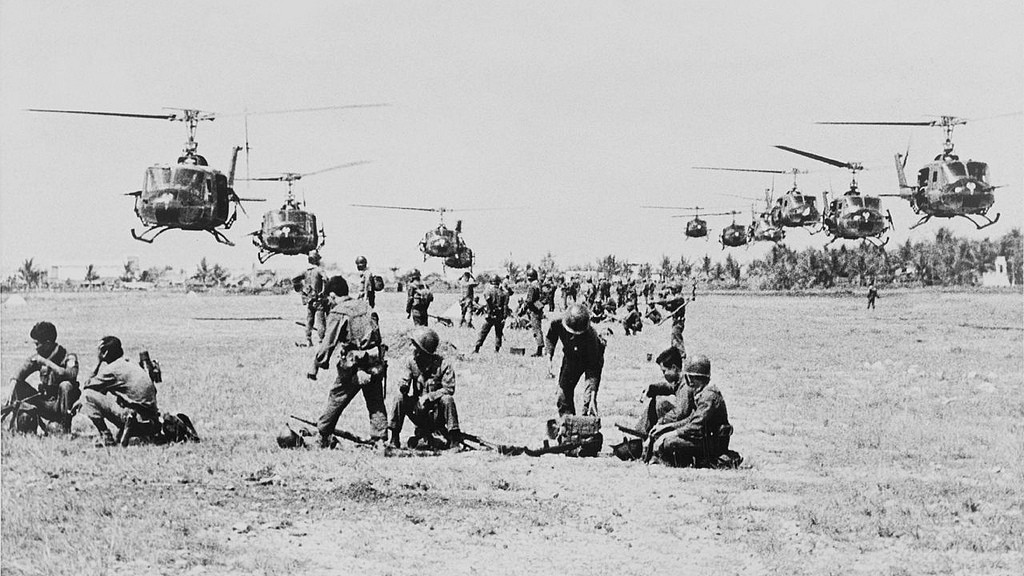U.S. and Allies Weapons
Infantry Weapon / M16
Until early 1960s, M14 was still the primary infantry weapon in Vietnam. Although accurate and powerful with its 7.62mm ammunition, M14 was heavy and unwieldy. Using 7.62mm cartridge, M14 was also virtually uncontrollable in full automatic mode. In order for the troops to have a more suitable weapon for the war in Vietnam, Robert McNamara, Secretary of Defense, ordered M16 as a replacement of M14 in 1964.
At first, M16 received some objection from soldiers who had backed the M14. Some disgruntled troops even derided the first model M16 as a frail “Mattel toy” because of its 5.56mm ammunition. Moreover, when its first design reached US troops in March 1965, it came with inoperable problems that the gun often suffered from a stoppage while firing. This led to many unnecessary loss of life which eventually brought a Congressional investigation. However, the problem was quickly resolved and M16 became a respected weapon and standard service rifle of the Vietnam War since then.
It was capable to fire in both semi and full automatic mode with an effective range of 300 meters and a rate of fire of 700-900rpm. According to a report of Department of Defense in 1968, M16 achieved widespread acceptance, only 38 of 2,100 individuals wanted to replace it with another weapon.
Helicopter / UH-1 Huey
Due to the lack of conventional warfare, tanks were hardly use in Vietnam. Instead, U.S. Army utilized military helicopters as part of its air cavalry – a new counter-guerrilla tactic.
Among those helicopters used during the Vietnam War, the Bell UH-1 Iroquois (nickname Huey) was one of the most recognized helicopters. Because of its high mobility, the Huey’s role in combat expanded enormously from rapidly transported personnel into the war zone to evacuate wounded soldiers to safer areas. The heavily armed Huey also offered a fearsome close air fire-power in supporting ground forces. With approximately 7000 UH-1 served in Vietnam, the Huey is the ubiquitous symbol of the American War in Vietnam.
Air Power
In the Vietnam War, new tactics and technological advances were implemented in battle and achieved varying degrees of success. To deal with the sophisticated North Vietnamese air-defense systems, squadrons of F-105 Thunderchiefs, equipped with anti-radar missiles and bombs, baited enemy’s anti-aircrafts into using their radar to target them, whereupon the radar waves were traced back to their source allowing the F-105s to precisely locate the target. These tactics came to be known as Wild Weasel which had became an integral part of any successful modern air campaign. In large-scale aerial bombardment, heavy bombers like the B-52 along with fighter planes like the F4-Phantom dominated the skies and caused vastly destruction to the land and population of North Vietnam. From 1964 to 1973, U.S. Air Forces dropped about 8 million ton of bombs in Vietnam, two times the amount of bombs that was dropped during World War II.
North Vietnamese and Viet Cong Weapons
Infantry Weapon / AK47
In the Vietnam War, most of North Vietnamese and Viet Cong’s weapons and equipments came from Soviet Union and China. For instance, AK-47, which was officially used by the Soviet Armed Forces, became the primary infantry weapon of NVA and the Viet Cong.
Regarded as the most widely used assault rifles in the world, AK-47 was sturdy, compact, reliable, and extraordinary durable. It was able to fire 7.62mm ammunition either semi and full automatically at a rate of 600 rpm and at a range of 400 meters. It was also more durable and less affected by the conditions in Vietnam. During the war, some American soldiers preferred it more than their standard M16. In a number of cases, when combat conditions permitted, some American troops did use AK-47 in their combat operation.
Booby Traps
As part of guerilla warfare, booby traps were often used by Viet Cong to slow down and disrupt the enemy force’s mobility. They also played a key role in prearranged killing zones and served as a signal to spring an ambush.
There were variety types of booby traps which could be divided into two types: explosive and non-explosive devices. Among the non-explosive devices, punji stake, bear traps, crossbow traps, double-spike caltrops were the most common types. In addition, variations of explosive devices, including mud ball mine, grenade in tin can mine, cartridge trap were also widely used by Viet Cong. Booby traps induced severe mental fatigue by putting the soldiers in the field under stress the whole time. It even caused a long-lasting psychological impact. From January 1965 to June 1970, about 11% of the fatalities and 17% of the wounds of the U.S. troops were caused by booby traps and mines.
Anti-Aircraft
By late 1964, North Vietnamese air defense had no more than 700 anti-aircraft artillery (AAA) weapons. However, when the United States began its bombing campaign in 1965, North Vietnam soon received many air defense equipment from China and Soviet Union. Since then, they began to develop one of the most sophisticated anti-aircraft defense systems in the world including AAA, Soviet-supplied MiG interceptors, radar links & surface-to-air missiles (SAMs).
North Vietnamese anti-aircraft system was supplied a wide variety of guns, ranging from the 22m ZU-23 (firing range 2.5 km) to the 100mm KS-19 (firing range 21 km). In summer of 1965, with the help of Soviet Union, the SA-2 Guidelines were also deployed near Hanoi and Hai Phong. By 1968, North Vietnam began to marry radar tracking to many of its AAA weapons. With the help of radar, the effective range of North Vietnamese AAA now covered from 500 to more than 12,000 meters. From 1965 to 1975, US aircraft suffered heavy losses from North Vietnamese with 1737 aircrafts shot down.
